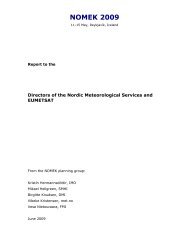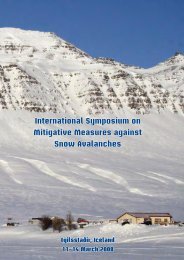- Page 1 and 2: NORTHERN HYDROLOGY AND ITS GLOBAL R
- Page 3 and 4: NORTHERN HYDROLOGY AND ITS GLOBAL R
- Page 5 and 6: LIST OF CONTENTS VOLUME 1 Preface .
- Page 7 and 8: Session 4: Uncertainty And Extremes
- Page 9 and 10: Astrid Voksø: Using Gis To Calcula
- Page 11: PREFACE This is the fifth Nordic Hy
- Page 15 and 16: NORTHERN HYDROLOGISTS AND THEIR GLO
- Page 17 and 18: In more recent years, Nordic hydrol
- Page 19 and 20: a pioneer in Finland’s ice invest
- Page 21 and 22: water that can be withdrawn e.g. fo
- Page 23 and 24: initiated through Nordic IHD cooper
- Page 25 and 26: consolidation of hydrological inves
- Page 27 and 28: field, like internal or external po
- Page 29 and 30: Bogen, J., Walling, D.E. and Day, T
- Page 31 and 32: Tallaksen, L. and van Lanen, H.A.J.
- Page 33 and 34: Annex 2 Non-exhaustive list of posi
- Page 35 and 36: NORDIC HYDROLOGY IN CLIMATE CHANGE
- Page 37 and 38: Lake Urriðavatn is rich on vegetat
- Page 39: under strict requirements on enviro
- Page 43 and 44: By using StormTac the concentration
- Page 45 and 46: The IKEA lot on the peninsula north
- Page 47: SESSION 2: ARCTIC HYDROLOGY AND GLA
- Page 50 and 51: INTRODUCTION The problem of the ass
- Page 52 and 53: The first approach is based on a co
- Page 54 and 55: In accordance with a tendency towar
- Page 56 and 57: ARCTIC HYDRA: THE ARCTIC HYDROLOGIC
- Page 58 and 59: increases) is affecting natural sys
- Page 60 and 61: • To provide feedback to data pro
- Page 62 and 63: SPATIAL PATTERNS OF DECLINE IN PAN-
- Page 64 and 65: (CGCM2, ECHAM4 and CCSR/NIES) and t
- Page 66 and 67: decreasing monitoring density have
- Page 68 and 69: 2002. Increasing river discharge to
- Page 70 and 71: for glaciated catchments, where hig
- Page 72 and 73: from 1996 to 2001, and the model wa
- Page 74 and 75: Figure 1. Change in precipitation (
- Page 76 and 77: the other hand, a raise throughout
- Page 78 and 79: Duration of a seasonal snow cover f
- Page 80 and 81: still be snow available during the
- Page 82 and 83: Laternser, M. Schneebeli, M. 2003.
- Page 84 and 85: THERMAL DYNAMICS OF SUB-ARCTIC LAKE
- Page 86 and 87: Figure 1. Lake Lagarfljót site wit
- Page 88 and 89: temperature of maximum density (4°
- Page 90 and 91:
Using the observed temperature diff
- Page 92 and 93:
temperature of river relative to di
- Page 94 and 95:
This analysis suggests that lake in
- Page 96 and 97:
THE INITIATION AND DEVELOPMENT OF A
- Page 98 and 99:
Figure 1. Discharge measured at Sve
- Page 100 and 101:
due to increasing strain in the ice
- Page 102 and 103:
DISCUSSION A jökulhlaup from the W
- Page 104 and 105:
HYDROLOGIC MODELING OF TWO CANADIAN
- Page 106 and 107:
THE SLURP MODEL The SLURP (“Semi-
- Page 108 and 109:
The models were calibrated using st
- Page 110 and 111:
Monthly runoff Observed and simulat
- Page 112 and 113:
Depth [mm] Depth [mm] 1000 800 600
- Page 114 and 115:
RADIATION BUDGET IN A SNOW-COVERED
- Page 116 and 117:
ICE CONDITIONS IN THE GULF OF RIGA
- Page 118 and 119:
Different approach for classificati
- Page 120 and 121:
2005 2004 2003 2002 2001 2000 1999
- Page 122 and 123:
REFERENCES Kostjukov J. 2002. Ice c
- Page 124 and 125:
Hydrological modelling is represent
- Page 126 and 127:
PROCESSES AND MORPHOLOGIES OF ICELA
- Page 128 and 129:
induced by a rapid temperature incr
- Page 130 and 131:
the elapsed time since the most rec
- Page 132 and 133:
debris apron formation and/or debri
- Page 134 and 135:
Malin, M.C., Edgett, K.S., Posiolov
- Page 136 and 137:
134
- Page 138 and 139:
significant increases in atmospheri
- Page 140 and 141:
P,mm 1000 900 800 700 600 500 400 1
- Page 142 and 143:
a days b days c Pmm 30 25 20 15 10
- Page 144 and 145:
Libiseller, C., Grimvall, A. 2002.
- Page 146 and 147:
Johnsson and Lundin (1991), Baker a
- Page 148 and 149:
Figure 2. Conceptual framework for
- Page 150 and 151:
Number of days with snow (avg.temp<
- Page 152 and 153:
Negative correlation Positive corre
- Page 154 and 155:
Soils. U.S. Army Cold Reg. Res. and
- Page 156 and 157:
LOW FLOW INDEX MAP FOR NORWAY - INT
- Page 158 and 159:
catchments derived automatically fr
- Page 160 and 161:
Figure 1. Catchment defined from a
- Page 162 and 163:
LONG-TERM CHANGES IN DISCHARGE REGI
- Page 164 and 165:
Table 1. Discharge observation peri
- Page 166 and 167:
DISCHARGE REGIME IN FINLAND Precipi
- Page 168 and 169:
not higher than 10%. Trends at the
- Page 170 and 171:
COMPARISON WITH OTHER STUDIES There
- Page 172 and 173:
Hyvärinen, V. and Vehviläinen, B.
- Page 174 and 175:
Kļaviņš et al. (2004), and river
- Page 176 and 177:
Table 1. Distribution of total annu
- Page 178 and 179:
and downward trend in 10 of 18 hydr
- Page 180 and 181:
Table 2. The results of Mann-Kendal
- Page 182 and 183:
Ration Q 30cold / Q annual mean 3 2
- Page 184 and 185:
INTEGRATED FRAMEWORK FOR ASSESSING
- Page 186 and 187:
Figure 1. Location of catchments us
- Page 188 and 189:
two GCMs, two emission scenarios an
- Page 190 and 191:
Percentage at or below given value
- Page 192 and 193:
Beldring, S., Engeland, K., Roald,
- Page 194 and 195:
• Increased precipitation, larges
- Page 196 and 197:
Consequences are that the model sho
- Page 198 and 199:
Figure 2. Measured and calculated h
- Page 200 and 201:
CONCLUSION AND DISCUSSION Figure 2
- Page 202 and 203:
STUDY OF HYDROLOGICAL PROCESSES FOR
- Page 204 and 205:
The latest version METQ2007BDOPT an
- Page 206 and 207:
scenario climate from 2071 to 2100
- Page 208 and 209:
Table 2. Optimal parameter values o
- Page 210 and 211:
Table 3. The obtained statistical c
- Page 212 and 213:
MODELLING OF CURRENT AND FUTURE WAT
- Page 214 and 215:
RESEARCH AND IMPLEMENTATION OF ALTE
- Page 216 and 217:
companies such as Statoil, Norsk Hy
- Page 218 and 219:
Therefore, the second project was o
- Page 220 and 221:
2. Development of new technical sol
- Page 222 and 223:
220
- Page 224 and 225:
222
- Page 226 and 227:
physical consistency. Finally, poss
- Page 228 and 229:
common weather state, modelled by t
- Page 230 and 231:
55 ° N 60 ° N 0 ° 5 ° E 10 ° E
- Page 232 and 233:
Modelled lag-0 cross-correlation Mo
- Page 234 and 235:
Weather states 100 125 0 0.25 0.5 0
- Page 236 and 237:
moisturized by the Baltic Sea. Thus
- Page 238 and 239:
DYNAMICAL DOWNSCALING OF PRECIPITAT
- Page 240 and 241:
64 ◦ N and 19.5 ◦ W, with a hor
- Page 242 and 243:
Figure 2: Overview of the six ice c
- Page 244 and 245:
Areal integrals of winter balance o
- Page 246 and 247:
comparatively high altitude outlet
- Page 248 and 249:
DYNAMICAL DOWNSCALING OF PRECIPITAT
- Page 250 and 251:
tions to agree with measurements in
- Page 252 and 253:
Figure 3: Ratio [%] of "false alarm
- Page 254 and 255:
events (only observed precipitation
- Page 256 and 257:
Table 1: Comparison of observed and
- Page 258 and 259:
A SCALING METHOD FOR APPLYING RCM S
- Page 260 and 261:
al., 1997) for Torpshammar, but for
- Page 262 and 263:
where αObs and βObs, αObs,95 and
- Page 264 and 265:
Figure 3. Distribution of precipita
- Page 266 and 267:
captured. The inclusion of a second
- Page 268 and 269:
THE NET EFFECT OF SAMPLE VARIABILIT
- Page 270 and 271:
the range of interest, i.e. all the
- Page 272 and 273:
Algorithm 1 For u = 1, K, U 1. for
- Page 274 and 275:
Table 1. Description of the eight g
- Page 276 and 277:
that the total variance can be well
- Page 278 and 279:
INTRODUCTION The Icelandic hydromet
- Page 280 and 281:
BAYESIAN STATISTICS Bayesian statis
- Page 282 and 283:
and discharge adequately. One accep
- Page 284 and 285:
Figure 3. The same rating curves as
- Page 286 and 287:
in publication by Reitan and Peters
- Page 288 and 289:
FLOOD RISK OF COASTAL AREAS TALLINN
- Page 290 and 291:
from the hydrometric station Pirita
- Page 292 and 293:
measurements in Tallinn coastal sta
- Page 294 and 295:
Table 2. The obtained maximum water
- Page 296 and 297:
Klibasev, К. And Goroskov, I, 1970
- Page 298 and 299:
INTRODUCTION This study is on the f
- Page 300 and 301:
Intensitet [l/s·ha] 1000 100 10 Re
- Page 302 and 303:
Intensitet [l/s·ha] Intensitet [l/
- Page 304 and 305:
ON THE ROAD TO A NEW NATIONAL HYDRO
- Page 306 and 307:
Table 1. Main polygons and lines in
- Page 308 and 309:
A) B) C) D) Figure 2. Different typ
- Page 310 and 311:
����ËÁ�Æ�ËÌÁÅ�
- Page 312 and 313:
ÅÓ��Ð ÁØ�ÔØÙÖ�×Ø
- Page 314 and 315:
����Ö�Ò���ØÛ�
- Page 316 and 317:
���������
- Page 318 and 319:
��Ú��Ø�ÓÒ�ÖÓÑØ











